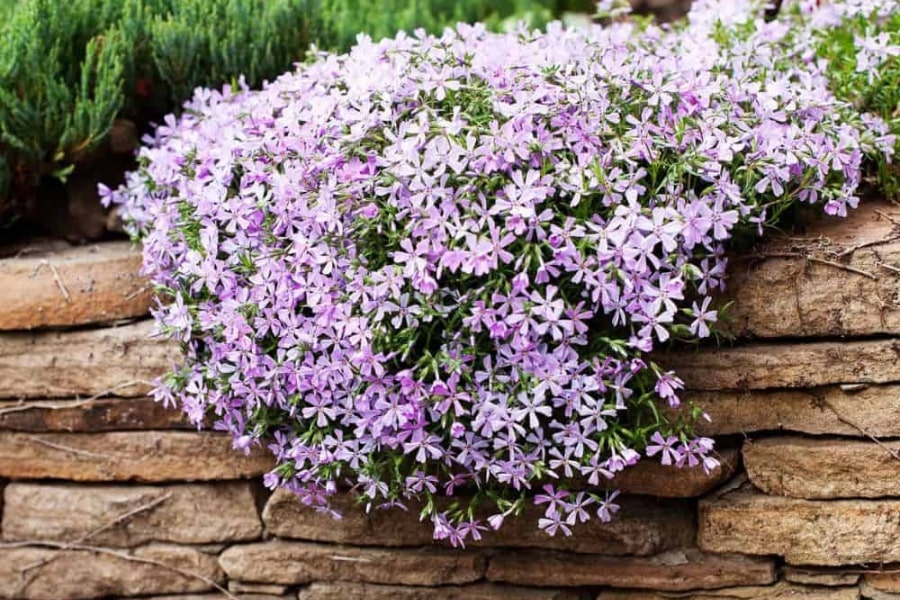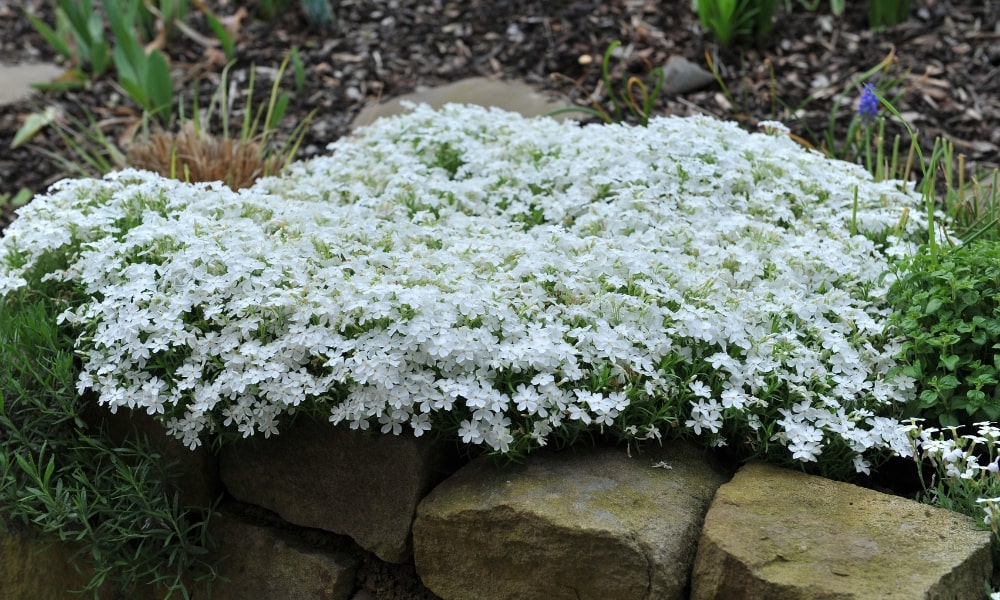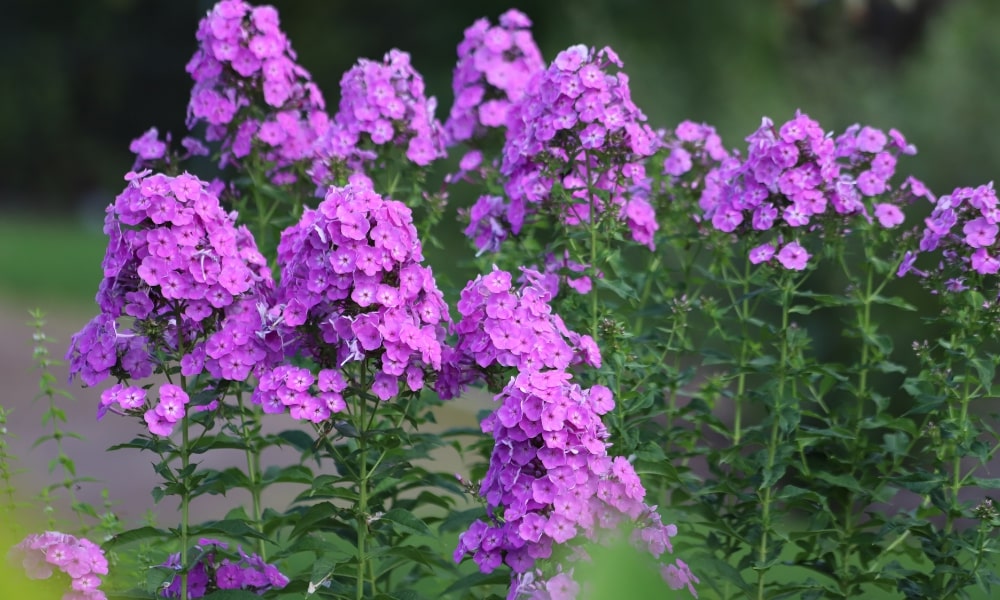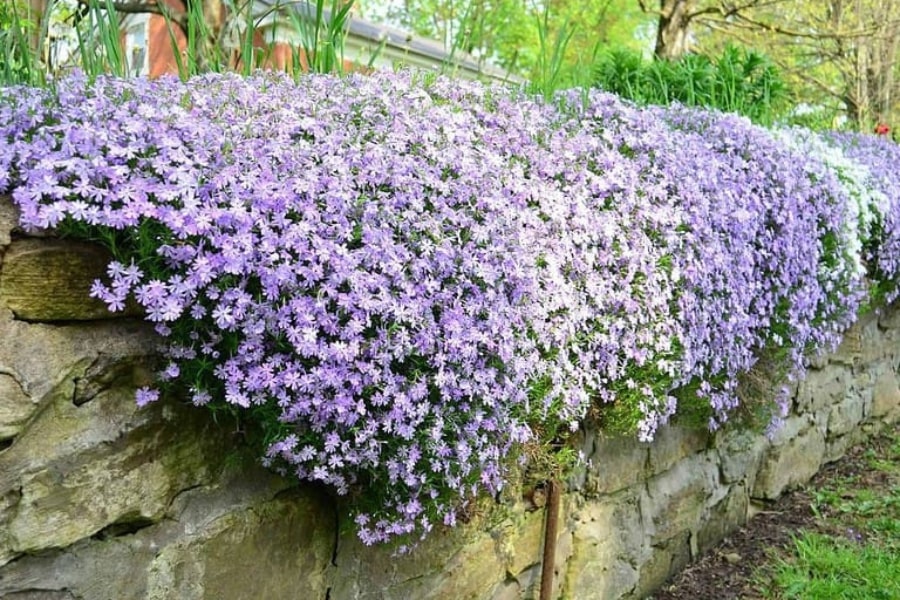Phlox, commonly known as thrift or sea pink, is a genus of flowering plants that belong to the Polemoniaceae family. There are around 70 species of phlox, which are native to various regions of North America, Asia, and Europe. With its delicate blossoms and lush foliage, Phlox is a perennial favorite among garden enthusiasts, offering a visual symphony that transcends seasons.
The two most common types of phlox are subulata and paniculata. Phlox subulata is early blooming and commonly known as Creeping Phlox. Generally, they bloom in early spring from February through April. Phlox paniculata is summer blooming and commonly called Garden Phlox, and sometimes known as Tall Phlox.

Our Selection Of Phlox
Creeping Phlox is super popular in the Spring. At Martin Garden Center, we will sell these exclusively in 4″ containers. We begin stocking Creeping Phlox (subulata) in February and usually are sold out by April. We are growing the following varieties in 2025:
Garden Phlox (paniculata) typically does not show up until late June or early July. All of these plants are grown in 4″ containers, though we may, from time to time, we may receive some 6″ or 1-gallon containers of Garden Phlox. We are growing the following varieties in 2025:
Growing and Caring For Phlox
Phlox thrives in full sun or partial shade; we recommend planting it in an area that gets at least six hours of direct sunlight each day. Placing Phlox in a sunny spot allows it to produce robust flowers and maintain its overall vitality. Well-draining soil is crucial for Phlox’s health and growth. The plant prefers soil rich in organic matter and allows excess water to drain away, preventing root rot. While Phlox is adaptable to different soil types, it thrives in soils with a slightly acidic to neutral pH.
Consistent watering is important during Phlox’s establishment phase. Once the plant has established itself, it is relatively drought-tolerant and can withstand periods of dryness. Avoiding overwatering helps prevent waterlogged conditions that can harm the plant’s root system. Creeping Phlox is particularly vulnerable to overwatering, but it will prosper with neglect. Only during drought periods should you EVER water creeping phlox.
Creeping Phlox requires no maintenance. However, with upright/garden Phlox, deadheading spent flowers is crucial for prolonging the blooming period and encouraging the development of new blossoms. Removing faded blooms of garden Phlox redirects the plant’s energy from seed production to the growth of fresh flowers. Phlox benefits from a balanced, slow-release fertilizer applied in the spring. Excessive fertilization should be avoided, as it can lead to leggy growth and reduced flowering.
Creeping Phlox are relatively disease and pest-resistant, but it’s still a good practice to monitor for any signs of pests and address them if necessary. Phlox is somewhat susceptible to powdery mildew. Watch closely when the autumn nights are cool for signs of mildew. Copper fungicide is an organic pesticide that helps prevent powdery mildew.

Leaves and Flowers
Creeping phlox foliage creates a mat or cushion of hairy linear leaves on tender stems, resembling moss, thus resulting in its name of Moss Phlox. Garden Phlox on the other hand has slender, lance-shaped opposite leaves on an upright slender stem.
The hallmark of Phlox’s allure lies in its exquisite blossoms, which showcase an array of captivating colors and delicate forms. The flowers are composed of 5 distinct petals. For creeping Phlox, they tend to be separated and star-shaped. For garden Phlox, the flowers are grouped in panicles and often have a scent. These petals come in hues of blue, pink, lavender, white, and even bi-colored varieties. The flowers create a captivating display that beckons pollinators and garden admirers alike.
While creeping Phlox have a relatively short blooming period limited to early spring, garden/upright Phlox flowers have a relatively long blooming period, extending from early summer to early fall.

Uses in the Garden
Subulata (creeping) Phlox’s compact growth habit and stunning flowers make it an excellent choice for borders and edging along garden pathways or flower beds. Creeping Phlox can also be planted in mass groupings to create eye-catching displays of groundcover color that command attention.
This low-growing plant is native to North America and is often used as a ground cover in rock gardens and border plantings. It produces dense mats of evergreen foliage covered in a profusion of small, star-shaped flowers in shades of pink, white, and purple in the spring.
The nectar-rich flowers of garden upright Phlox attract a variety of pollinators, including bees, butterflies, and hummingbirds, making it an essential addition to pollinator-friendly gardens. Garden phlox also makes great back-border plants.

Frequently Asked Questions
Do Deer Eat Phlox?
Phlox, with its fragrant blossoms and lush foliage, isn’t typically at the top of a deer’s menu. However, in moments of scarcity or when temptation beckons, a curious deer might indulge in a nibble. Thus, while phlox may enjoy a degree of deer resistance, the gardener’s watchful eye and strategic defenses remain essential in preserving the harmony of the floral landscape.
Is Phlox A Perennial?
Yes, phlox is a perennial plant. There are several species and cultivars of phlox, but each comes back year after year when provided with suitable growing conditions.
Is Phlox Poisonous To Cats and Dogs?
Phlox plants are generally considered non-toxic to cats and dogs. The American Society for the Prevention of Cruelty to Animals (ASPCA) does not list Phlox (Phlox spp.) as toxic to pets. The plants are not known to contain substances particularly harmful to cats or dogs if ingested.
Do Rabbits Eat Phlox?
Rabbits generally tend to avoid eating phlox. While no plant can be guaranteed to be completely rabbit-proof, phlox is typically not their preferred choice for browsing.
